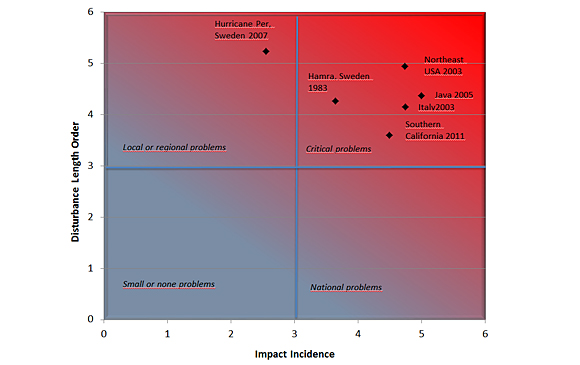A Richter Scale for Power Outages
NEWS
A KTH researcher has developed a calibrated system to measure the effects of electric power cuts similar to the Richter scale that indicates the strength of earthquakes. The idea is to increase understanding of how society is affected by power outages and help forecast the return on investments in more secure electrical networks.
Developed under the working title Viking Impact Magnitude, the new system rates outages on a scale from 1 to 10, obtained by multiplying the number of affected people by the duration of the interruption. Behind the innovation is Mats B.O. Larsson, a PhD candidate in the Department of Industrial Information and Control Systems at KTH.
Larsson’s scale was born from his work with the EU-funded research project Viking, which looks at reducing the vulnerability of increasingly interconnected electrical networks to technical failures, computer hacking and natural disasters. The aim is to be able to present the damage from blackouts for the press, politicians and the public in a form that’s easily understood. The scale enables precise determination of different levels of disruption, and the impacts on societal functions caused by service interruptions.

“People can relate to a scale like this,” Larsson says. “For example, Cyclone Per [which hit the west coast of Sweden and Norway in January 2007] had an Impact Magnitude of 7.7 on the scale, comparable to an earthquake. As many as 440,000 electricity consumers were without power for up to 10 days. The scale can be used on all types of outages, whether they’re caused by a hacker attack or an autumn storm,” he adds.
The Impact Magnitude scale is designed to make it simple for analysts to estimate how one event compares to another. “Power outages are traditionally presented publicly as costs. But it’s difficult and time consuming to do the detailed analysis you need to calculate costs. With this scale, it only takes a few minutes to determine roughly how big the damage will be.”
Viking Impact Magnitude may have applications beyond the electricity sector, such as estimating the effects of social unrest and other disruptions to daily life. “A shutdown of mobile phone networks could be measured the same way, or interruptions in Internet connectivity or water supplies,” Larsson says.
Viking Impact Magnitude can be divided into two categories, with 0 to 7 being smaller, regional disruptions, and 7 to 10 indicating larger or longer-term national disturbances.

Larsson has applied Viking Impact Magnitude to three large, well-known power outages. On December 27, 1983, two-thirds of the Swedish network was shut down when a single component in a switching station failed, causing a short-circuit in a transformer. Larsson estimates the Impact Magnitude of that event at 7.9.
In 2003, a software failure completely blacked out large portions of the northeastern United States, affecting 55 million people. Martial law was declared and the estimated economic cost rose to some $4 billion. Impact Magnitude: 9.67.
Finally, data from Cyclone Per was input into Viking Impact Magnitude. The storm claimed five lives, felled some 16 million cubic meters of timber and caused regional disturbances across southern Sweden. Impact Magnitude: 7.7
By Peter Larsson. Edited by Kevin Billinghurst